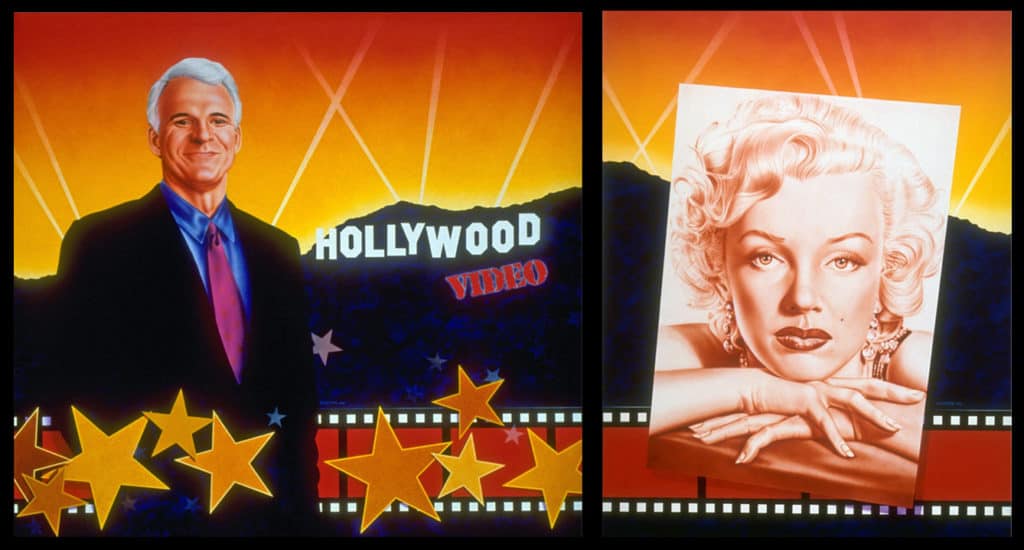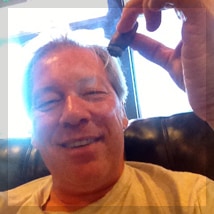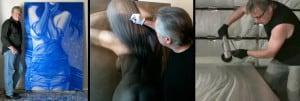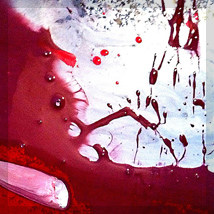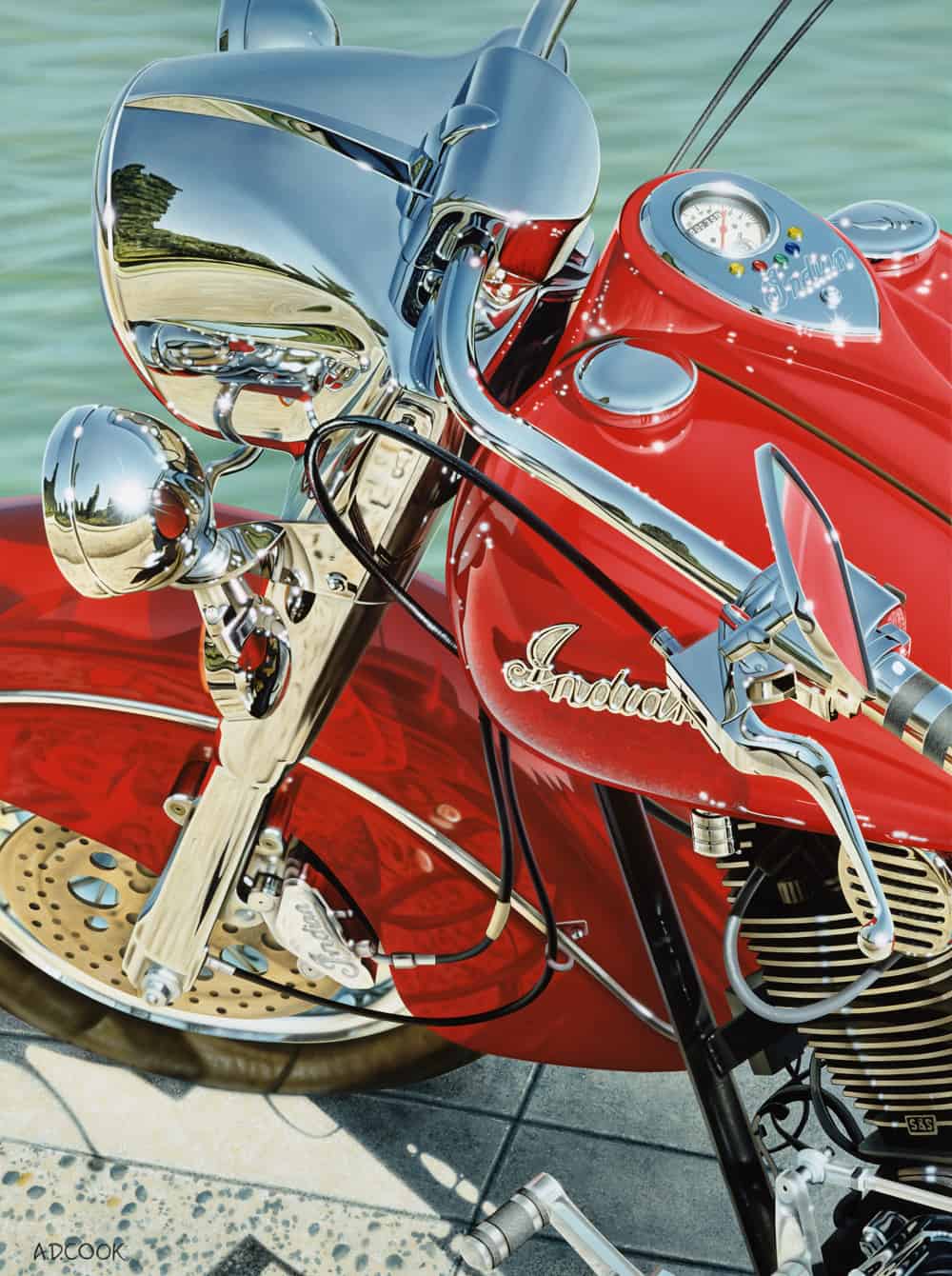
Indian Summer, 48″ x 36″, acrylic on canvas, 2001
Continued from Disasters and Recovery, Part 1
Indian Summer
Few people know that my INDIAN SUMMER motorcycle painting experienced a colossal disaster halfway through creating it. So did BACKDRAFT, one of my better-known life-size fine art nudes.
My big faux pas with INDIAN SUMMER was similar to others—a simple operator error. I was airbrushing the water background portion of the painting with gentle blends of duck pond green when the cap popped off my airbrush. I presumed it was secure, but I most likely failed to double-check everything before spraying. As a result, I was instantly horrified as paint splashed out of the airbrush and ran down my canvas.
You can’t do much in that situation except grab a rag and gently dab the spilled paint up. But, as you can imagine, it left a big ugly aqua-green stain on my otherwise beautiful nearly-finished background.
After wiping off my easel and cleanup, I masked and repainted the damaged area, setting me back only a couple of hours and a few ounces of paint. Once repaired, it looked as good as before my crisis, and I was ready to move on and finish my artwork, a bit more mindful of the experience.
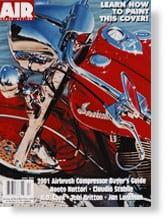 INDIAN SUMMER was featured on the cover of Airbrush Action magazine in April 2001 for my article “A Study in Chrome and Reflective Surfaces.” In that two-part essay, I cover how to paint the illusion of chrome on canvas. Reading the article, you’ll note that I omitted any mention of the accident or damage control because it doesn’t matter as long as the final result is incredible. Besides, after fixing the water, the background looked even better. Because it looked more pleasing, the motorcycle looked better, and so on. So, in a way, that nasty little accident made me raise the bar on the painting overall—a happy little accident.
INDIAN SUMMER was featured on the cover of Airbrush Action magazine in April 2001 for my article “A Study in Chrome and Reflective Surfaces.” In that two-part essay, I cover how to paint the illusion of chrome on canvas. Reading the article, you’ll note that I omitted any mention of the accident or damage control because it doesn’t matter as long as the final result is incredible. Besides, after fixing the water, the background looked even better. Because it looked more pleasing, the motorcycle looked better, and so on. So, in a way, that nasty little accident made me raise the bar on the painting overall—a happy little accident.
Catastrophes are not a formula for success; I would never recommend them to anyone outside of perhaps the abstract art community. But when it comes to realism art, believe me when I tell you that nothing pleases me more than a disaster-free undertaking, but disasters are going to happen.
In the case of my INDIAN SUMMER painting, my reaction to the disaster positively impacted my painting, resulting in one of my most epic motorcycle pieces to date, landing on the cover of Airbrush Action and inclusion in a New York Art Show.
A few years after its cover debut, I sold the original artwork to a collector I met at the Sturgis Motorcycle Rally.
In two-thousand sixteen, museum Curator David J. Wagner requested INDIAN SUMMER for inclusion in the LUSTER Realism and Hyperrealism Automobile and Motorcycle Paintings exhibition. I am grateful that my collectors have graciously loaned their paintings for the national museum tour. As a result, INDIAN SUMMER has exhibited in fourteen significant museums across America through January twenty-twenty-three.
“An expert in anything was once a beginner.”
— Helen Hayes Tweet
BACKDRAFT
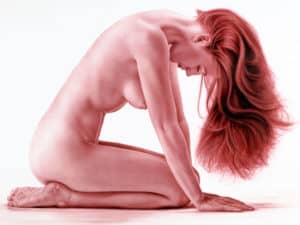 My BACKDRAFT painting has a similar story. A few years later, again, I failed to secure the cap on my airbrush, and its lid popped off as I painted long strands of hair. It was a disaster as red paint obliterated a considerable part of my painting. And like before, as with INDIAN SUMMER a few years earlier, I grabbed a rag and soaked up the spilled paint as fast as possible. Again, I was horrified, but I was grateful that the spilled paint was limited to her hair and not on her softly-airbrushed face and hands. I invested countless hours into painting BACKDRAFT’s long red hair, one strand at a time, and now it was a mess.
My BACKDRAFT painting has a similar story. A few years later, again, I failed to secure the cap on my airbrush, and its lid popped off as I painted long strands of hair. It was a disaster as red paint obliterated a considerable part of my painting. And like before, as with INDIAN SUMMER a few years earlier, I grabbed a rag and soaked up the spilled paint as fast as possible. Again, I was horrified, but I was grateful that the spilled paint was limited to her hair and not on her softly-airbrushed face and hands. I invested countless hours into painting BACKDRAFT’s long red hair, one strand at a time, and now it was a mess.
Fortunately, with BACKDRAFT, the solution was to repaint and add more hair, a lot more, and in the end, I liked the painting even more, and it became one of my favorite paintings ever.
THE BIG ONES
Earlier (in my book), I shared a little about my Hollywood Video Lethal Weapon mural and that I lost control of the painting. That mural was a complete disaster, and my only resolve was to paint my canvas white and start fresh with a new mural. That story worked out fine since I enjoyed painting the duotone Marilyn Monroe mural, and it remains one of my all-time favorite Hollywood murals.
As you may recall, the Marilyn mural was the right half of a two-piece mural, with the left panel featuring Steve Martin. When the Hollywood Video store in Beaverton, Oregon, closed, both canvas murals were ripped from the wall and piled amongst the construction debris. It saddened me to discover my artworks discarded so casually, but I was happy that neither had suffered any concerning damage. I quickly pulled them aside and went to a hardware store for two ten-foot-long PVC tubes to roll the murals up and return them to my studio. Later, when I left Hollywood Video, I asked if I could have them, along with a couple of others, and it was fantastic, so I took them and archived them in safe storage. A few years later, I shipped them all to Las Vegas, and the Steve Martin and Marilyn murals were eventually sold and installed in a mansion, along with my ten-foot by fourteen-foot Elvis and John Wayne mural. It was a huge house, and my murals looked great, finally displayed in a beautiful home at the Las Vegas Country Club Estates.
“It's not art unless it has the potential to be a disaster.”
— Unknown Tweet
But once again, as fate would have it, when the murals were removed from the mansion a couple of years later, whoever did the removal and storage of the murals was careless. I was shocked and bummed when my collector called and asked me to visit his new home to see the damaged murals as he rolled them out across the floor. Instead of rolling them around PVC tubes, they just rolled them up and wrapped masking tape around them. And to top it off, they put them in a garage and stacked boxes on them, disregarding their protection and value.
So, there I was, looking down on my two murals, which had been rolled and then flattened by the weight of everything stored on them for months.
As you can imagine, nasty cracks ran across the entire mural every few inches where it had been folded and crushed. My heart sank deeper as my collector’s cat casually strolled across the laid-out mural. Yet, I kept it inside because nothing was positive or uplifting about that presentation. So instead, I waited to see what he had in mind and how he thought this would get fixed. These are airbrushed murals, meaning they have micro-thin paint layers applied through the atomization of transparent pigments. – not an easy thing to fix. Beyond that, since the murals are on heavy canvas, they would never roll out flat again once rolled up and crushed.
I thought about it and probably should have avoided considering repairing either. But, sadly, the Marilyn mural was beyond repair. I offered a solution, however, to restore the Steve Martin mural the best I could, with no guarantee that my idea would even work, but if it could be fixed at all, I was the best guy to try.
I started by creating an eight-foot square panel from two four-foot by four-foot pieces that I mounted on an aluminum metal frame. Next, I used an industrial spray adhesive to glue the mural to my new panel and flattened out any ridges with a large roller like my dad used to install linoleum flooring. The glue set up fast, so with Beti’s help, we hustled and got it as flat as possible. It was quite a workout, and we were exhausted, but fortunately, that was pretty much it for the heavy lifting. Still, we knew that was only the beginning, and there was still lots to do. The mural was flat but still had cracks and paint chipped away from the folds.
We let the glue set overnight before trimming off any excess canvas the following day to clean up its damaged edges and accommodate its new panel. Then, finally, I was ready to paint. Again, with Beti’s help, we started at opposite ends of the canvas and touched up thousands of tiny spots, lines, and cracks with the same Com-Art paints I initially used to create the murals, only this time with small artist brushes as opposed to an airbrush. The more we painted, the more we discovered what needed to be fixed. It took a few days, but it looked pretty good when we finished. Next, it was delivered back to its owner, and that is the last I saw of it.
WHEN LIGHTING STRIKES
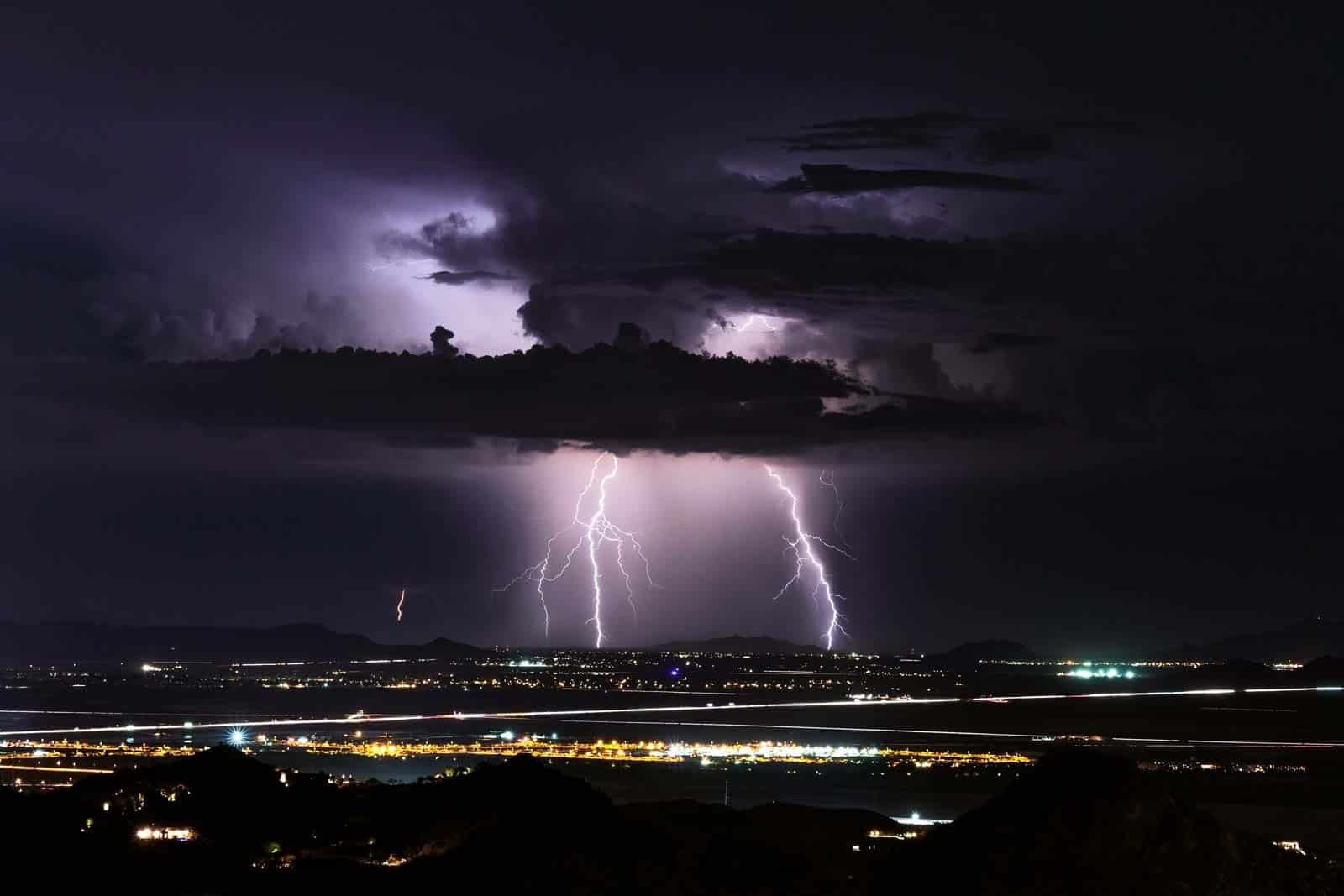
While man makes some disasters, other times nature has her way with our best-laid plans. Years ago, I was painting a large mural in a beautiful home in Phoenix, covering a ten-foot-wide wall floor to ceiling with a view of the valley with its desert sky at sunset. I enjoyed this project because I wanted to create the effect of standing at the mountain’s edge and looking over miles of city lights and the southern mountains silhouetted in the background. The wall was about twelve or thirteen feet tall, so I started at the top by painting the sunset and clouds.
While you can play around with painting clouds and skies because they are forever changing and more open to creative expression, mountains, landmarks, and roads are a bit less forgiving because they’re either correct or not. Unfortunately, there is little middle ground, and if there were, it would not matter because I wanted it to be as accurate as possible, regardless.
To create something authentic, I decided to hike up one of the many mountain trails in the north end of Phoenix to take pictures of the valley as my reference for the mural. I had a friend, Steve, who had been in a motorcycle accident and had lost a leg. He moved fast on his replacement aluminum leg and asked if he could join me on my hike. It turned out that didn’t slow me down as we raced upward to beat the weather. As a result, the sky was dynamic and perfect for my mural.
However, with a forecast of rain, clouds were already rolling in as Steve and I hiked to the top. I never considered it then, but I was carrying a metal tripod with a friend with a lightning rod as his left leg, with an impending lightning storm on the horizon. Later, I was told that we were lucky that we weren’t struck by lightning, making us eligible for matching Darwin Awards.
The hike and risk were worth it. My photos were just what I needed to complete my mural.
So, where was the disaster in my story? Neither Steve was hurt, and my pics were fantastic! However, a gripping tragedy occurred while we were on the mountaintop, not to us, but to my mural. While I was shooting my pictures of sunsets and lightning, the house where I was painting the mural was struck by lightning. It hit their air conditioning unit and traveled through the house, blowing out the metal trim and nails from the sheetrock on my mural wall, even launching nails and shrapnel across the room. Had I been there painting, I might have been zapped into oblivion. But, instead, it seems I may have escaped death twice that night. Oh, the things we do for art.
In repairing the wall, the construction guys destroyed what the lightning had not. So I had them repaint every inch and started my mural again from scratch. But, like other times, the disaster sometimes creates an opportunity to explore new solutions, and the result may be better through experience and resolution.
• • • • •
Read the Disaster and Recovery, Part 1
This story continues with Disaster and Recovery, Part 3

INSIDE THE BOX
The excerpt above is from INSIDE THE BOX, a forthcoming memoir by A.D. Cook © 2023.
Subject to edits and updates.
- About the Author
- Latest Posts
- More info
A.D. is an artist who started drawing at a young age. Throughout his life, he has worked with different creative tools in traditional and digital art and design. His art and writings have been showcased in various publications such as Airbrush Action Magazine, Airbrush Magazine, American Art Collector, Art & Beyond, Dream To Launch, Easyriders, Las Vegas City Life, Las Vegas Weekly, L’Vegue, ModelsMania, Quick Throttle, and The Ultimate Airbrush Handbook.

